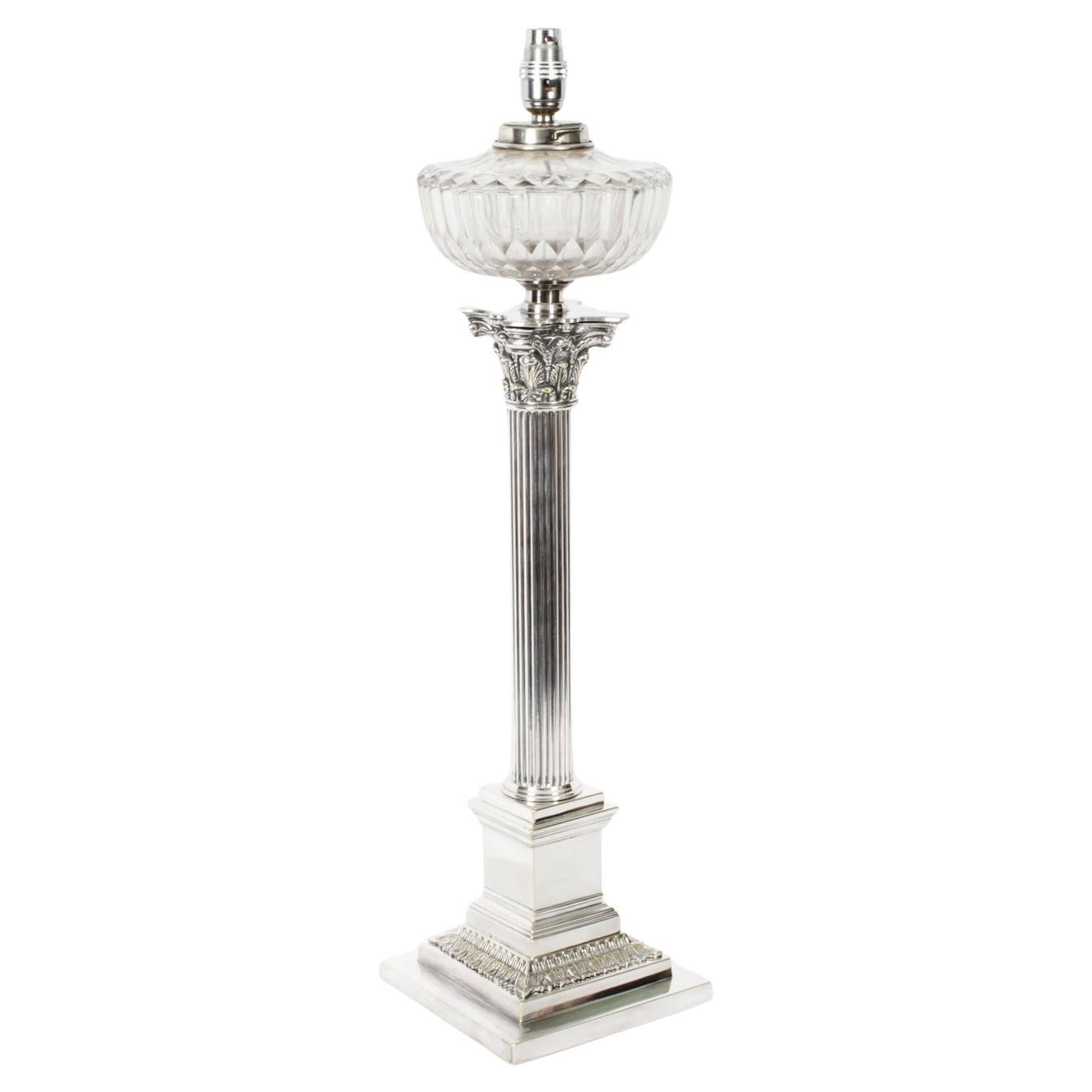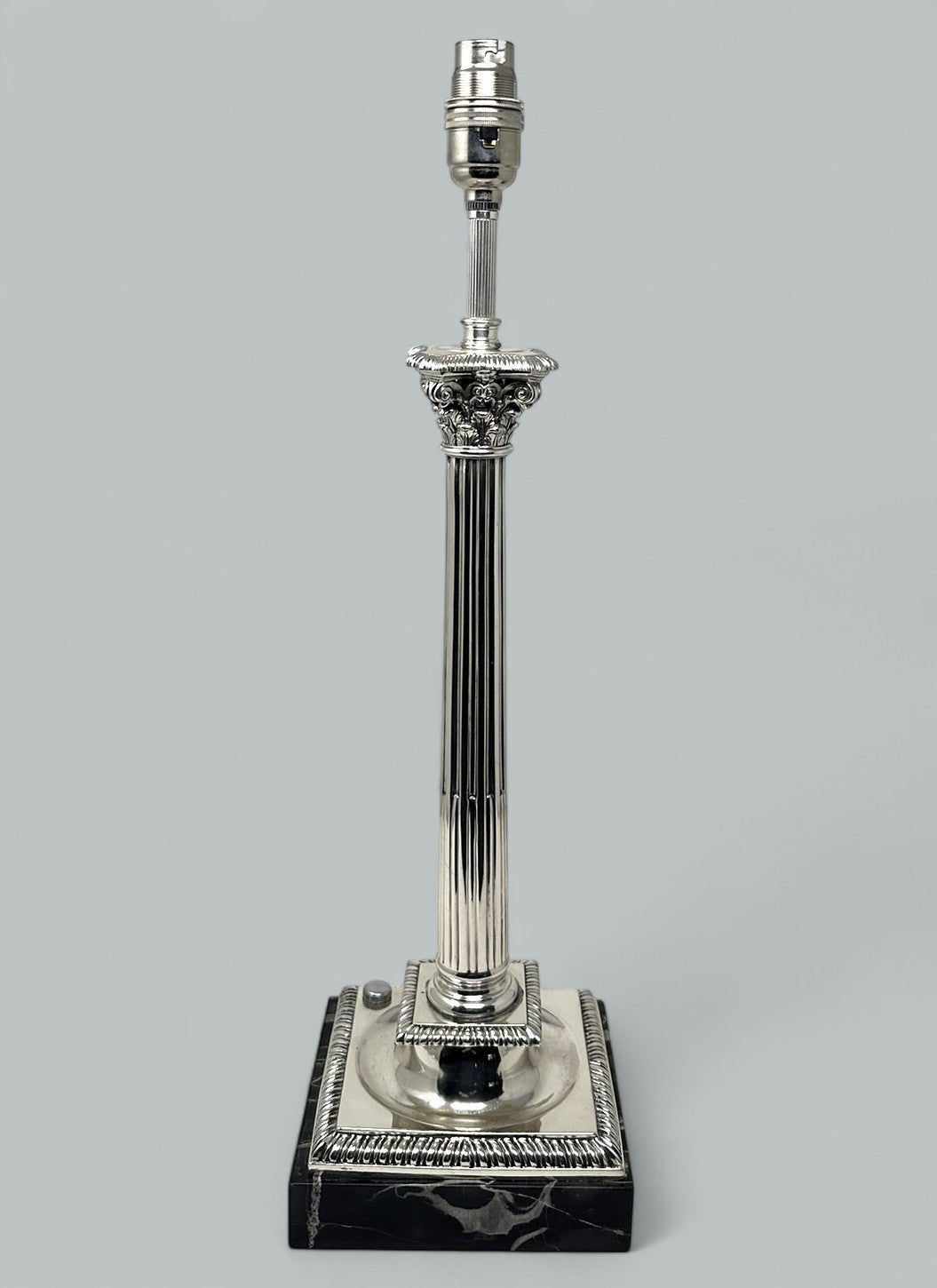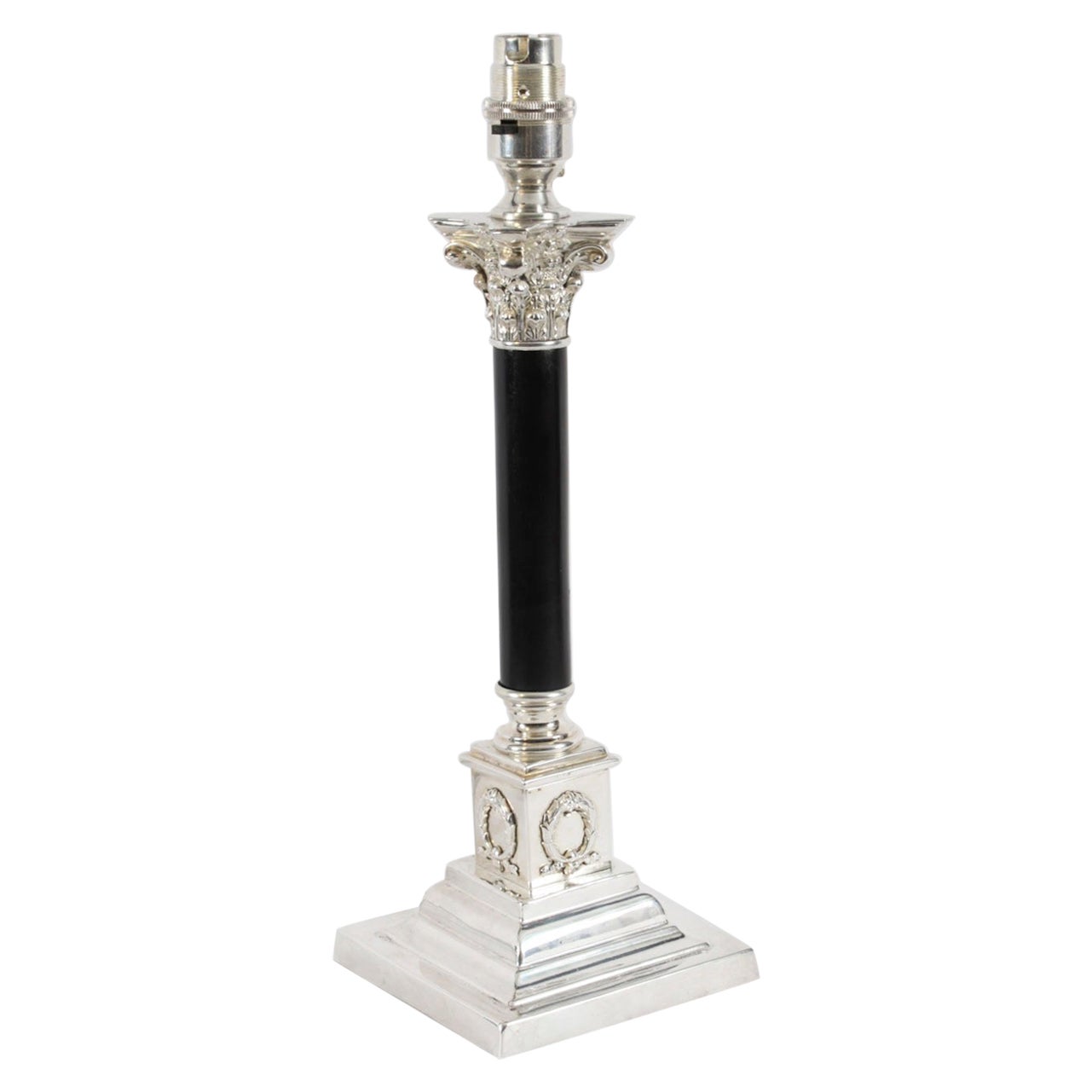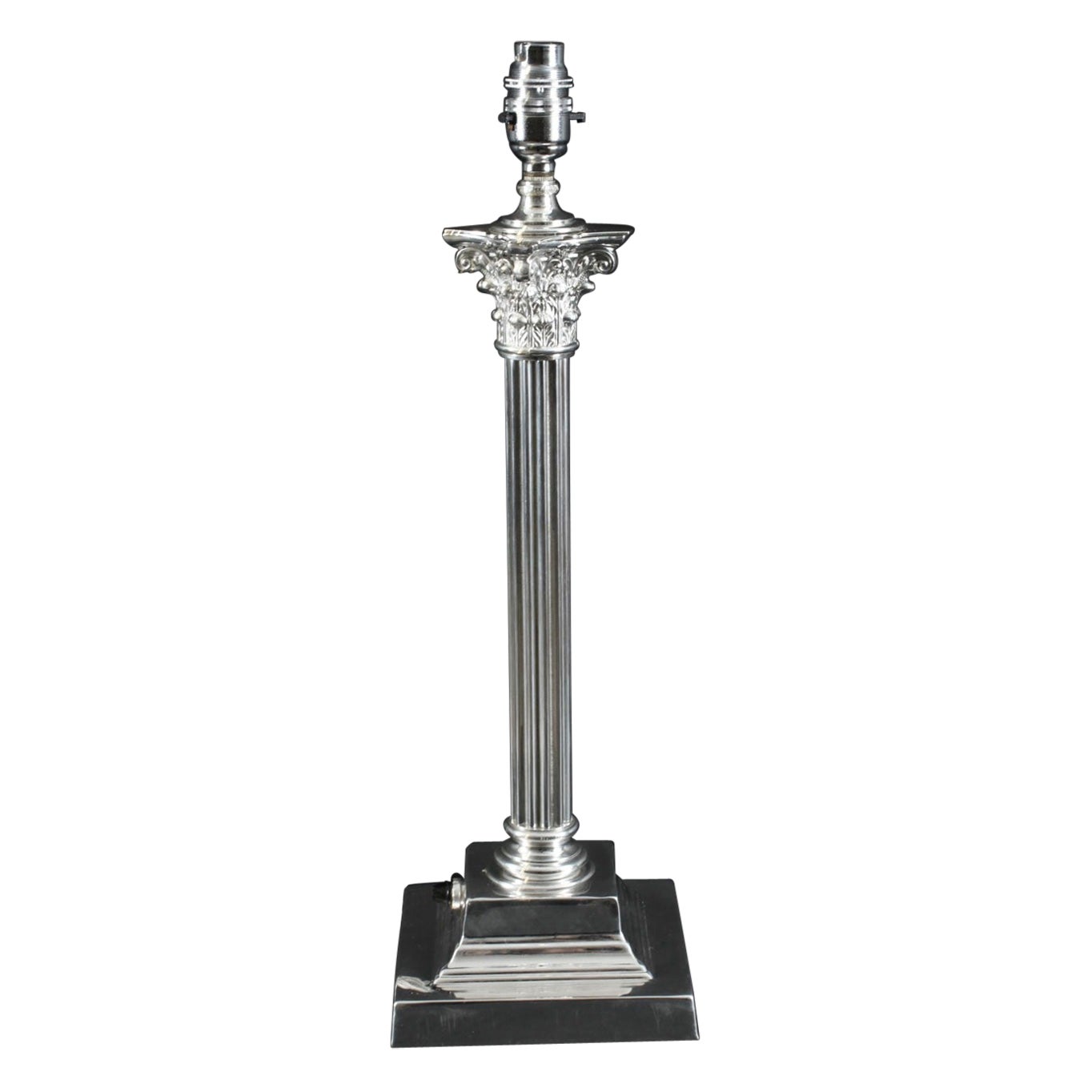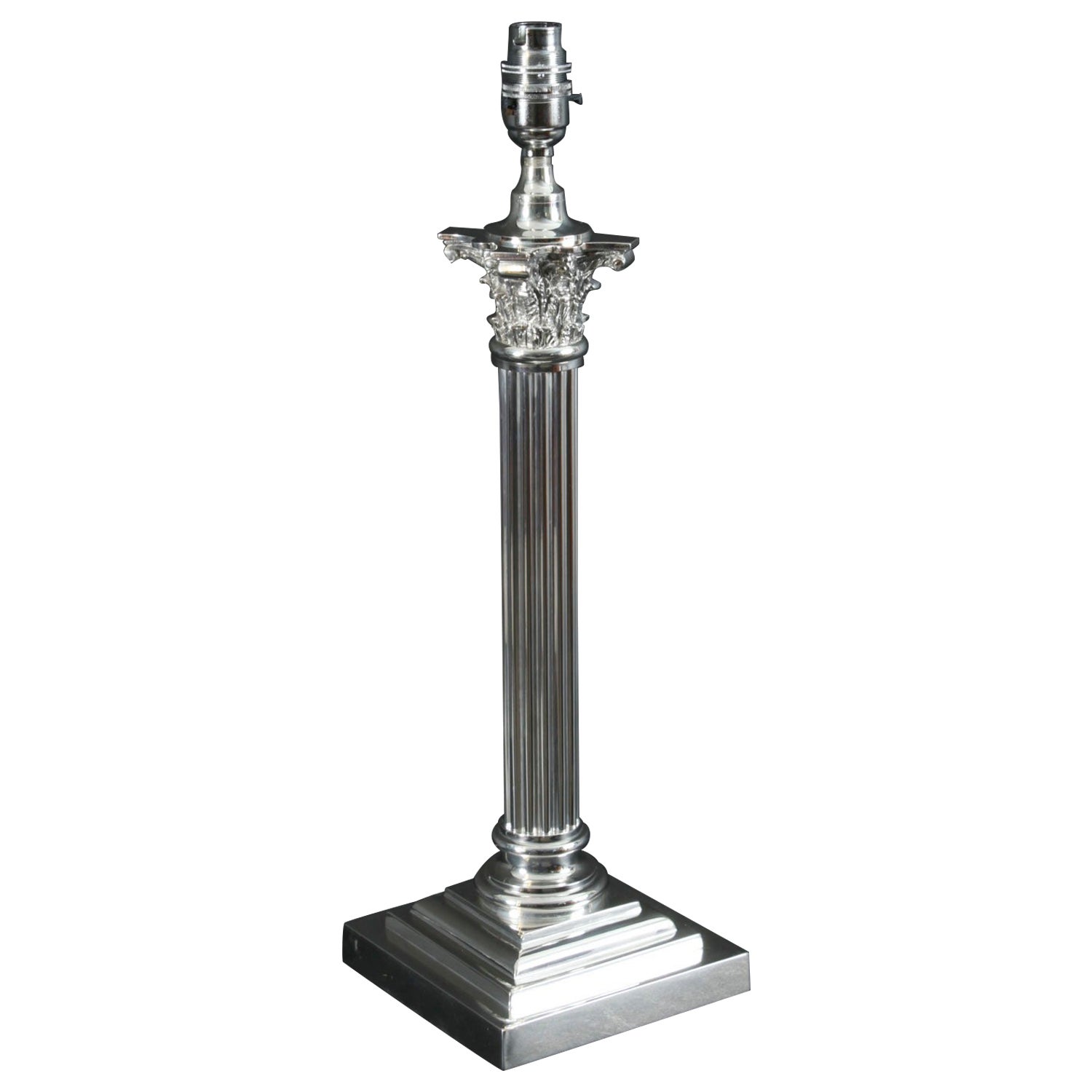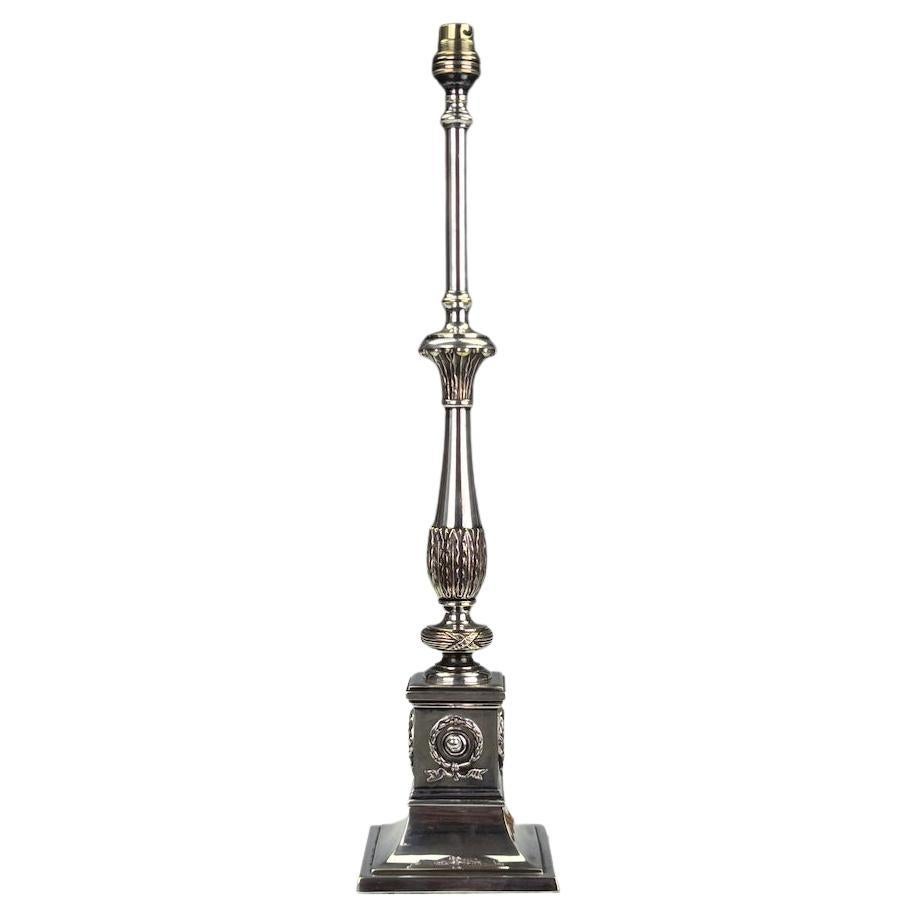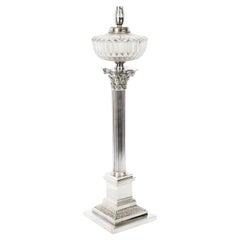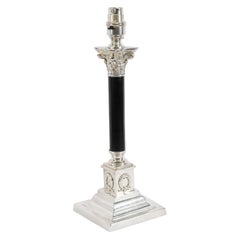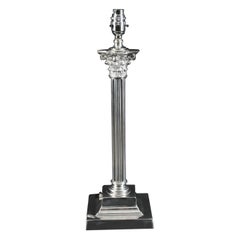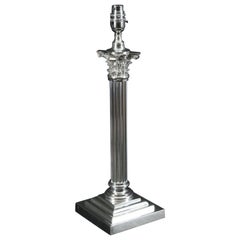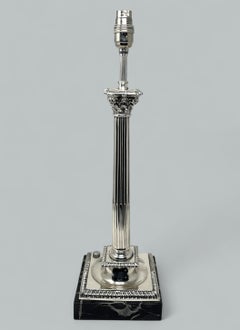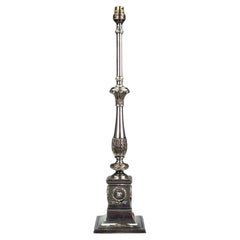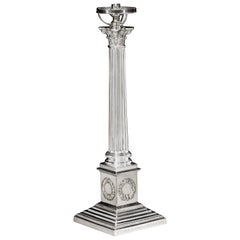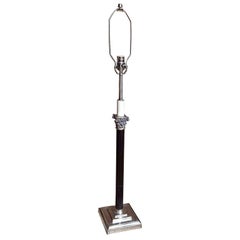Items Similar to Antique Edwardian Silver Plated Corinthian Column Table Lamp, Early 20th Century
Want more images or videos?
Request additional images or videos from the seller
1 of 10
Antique Edwardian Silver Plated Corinthian Column Table Lamp, Early 20th Century
$723.77
£525
€613.07
CA$1,000.74
A$1,098.69
CHF 573.19
MX$13,295.68
NOK 7,184.03
SEK 6,769.25
DKK 4,576.38
About the Item
This is an impressive antique Edwardian silver plated Corinthian column table lamp, circa 1910 in date.
It features a classic Corinthian Capital decorated with acanthus leaves and anthemion with a thin cylindrical fluted shaft on a circular pedistal raised on a square stepped base.
Add an element of pure luxury to your home with this antique silver plated table lamp.
Condition:
In excellent working condition having been beautifully cleaned and rewired, please see photos for confirmation.
Dimensions in cm:
Height 43 x width 10 x depth 10
Dimensions in inches:
Height 16.9 x width 3.9 x depth 3.9
Corinthian capital
It has been suggested that the foliage of the Greek Corinthian capital was based on the Acanthus spinosus, that of the Roman on the Acanthus mollis. The leaves are generally carved in two "ranks" or bands, like one leafy cup set within another. One of the most beautiful Corinthian capitals is that from the Tholos of Epidaurus (400 BC); it illustrates the transition between the earlier Greek capital, as at Bassae, and the Roman version that Renaissance and modern architects inherited and refined.
In Roman architectural practice, capitals are briefly treated in their proper context among the detailing proper to each of the "Orders", in the only complete architectural textbook to have survived from classical times, the Ten Books on Architecture, by Marcus Vitruvius Pollio, better known just as Vitruvius, dedicated to the emperor Augustus. The various orders are discussed in Vitruvius' books iii and iv. Vitruvius describes Roman practice in a practical fashion. He gives some tales about the invention of each of the Orders, but he does not give a hard and fast set of canonical rules for the execution of capitals.
Two further, specifically Roman orders of architecture have their characteristic capitals, the sturdy Tuscan capitals, typically used in military buildings, similar to Greek Doric, but with fewer small moldings in its profile, and the invented Composite capitals not even mentioned by Vitruvius, which combined Ionic volutes and Corinthian acanthus capitals, in an order that was otherwise quite similar in proportions to the Corinthian, itself an order that Romans employed much more often than Greeks.
Ancient builders developed several Orders, or rules, for the design and proportion of buildings, including the columns. Doric is one of the earliest and most simple of the Classical Orders set down in ancient Greece. An Order includes the vertical column and the horizontal entablature.
Doric designs developed in the western Dorian region of Greece in about the 6th century BC. They were used in Greece until about 100 BC. Romans adapted the Greek Doric column but also developed their own simple column, which they called Tuscan.
- Dimensions:Height: 16.93 in (43 cm)Width: 3.94 in (10 cm)Depth: 3.94 in (10 cm)
- Style:Edwardian (Of the Period)
- Materials and Techniques:
- Place of Origin:
- Period:1910-1919
- Date of Manufacture:circa 1910
- Condition:
- Seller Location:London, GB
- Reference Number:Seller: A1516d1stDibs: LU950622574952
About the Seller
5.0
Platinum Seller
Premium sellers with a 4.7+ rating and 24-hour response times
Established in 1983
1stDibs seller since 2012
1,398 sales on 1stDibs
Typical response time: <1 hour
Associations
LAPADA - The Association of Arts & Antiques Dealers
- ShippingRetrieving quote...Shipping from: London, United Kingdom
- Return Policy
Authenticity Guarantee
In the unlikely event there’s an issue with an item’s authenticity, contact us within 1 year for a full refund. DetailsMoney-Back Guarantee
If your item is not as described, is damaged in transit, or does not arrive, contact us within 7 days for a full refund. Details24-Hour Cancellation
You have a 24-hour grace period in which to reconsider your purchase, with no questions asked.Vetted Professional Sellers
Our world-class sellers must adhere to strict standards for service and quality, maintaining the integrity of our listings.Price-Match Guarantee
If you find that a seller listed the same item for a lower price elsewhere, we’ll match it.Trusted Global Delivery
Our best-in-class carrier network provides specialized shipping options worldwide, including custom delivery.More From This Seller
View AllAntique Victorian Silver Plated Corinthian Column Table Lamp 19th Century
Located in London, GB
This is a splendid antique Victorian silver-plated Corinthian column oil table lamp now converted to electricity, circa 1880 in date.
This decorative antique table lamp features an ...
Category
Antique 1880s English Victorian Table Lamps
Materials
Silver
Antique Victorian Corinthian Column Silver Plated Table Lamp 19th Century
Located in London, GB
This is a large and splendid antique Victorian silver-plated Corinthian column table oil lamp now converted to electricity, Circa 1870 in date.
This opulent antique table lamp featu...
Category
Antique 1870s English Victorian Table Lamps
Materials
Silver
Antique Victorian Silver Plate Corinthian Column Table Lamp 19th Century
Located in London, GB
This is a splendid antique Victorian silver plate columnar Corinthian column table lamp, now converted to electricity from an oil lamp,Circa 1980 in date.
This opulenttable lamp fe...
Category
Vintage 1980s English Victorian Table Lamps
Materials
Silver
Antique Silver Plated Corinthian Column Table Lamp Victorian 19th Century
Located in London, GB
A pair of early 20th Century brass column lamp stands.
This is a splendid antique Victorian silver plated columnar Corinthian column table lamp, now converted to electricity from an...
Category
Antique Late 19th Century English Victorian Table Lamps
Materials
Silver Plate
Antique Silver Corinthian Column Table Lamp Goldsmiths 1899 19th Century
Located in London, GB
This is an impressive large antique Victorian sterling silver Corinthian column table lamp bearing hallmarks for London 1899 and the makers mark of the world renowned silversmith Gol...
Category
Antique 1890s English Victorian Table Lamps
Materials
Silver
Antique Large Silver Plated Table Lamp by Palmer & Co 19th C
Located in London, GB
A superb silver plated brass table lamped, stamped Palmer & Co, and later converted to electricity, late 19th century in date.
The Puginesque column is raised upon an integrated ...
Category
Antique 1890s English Table Lamps
Materials
Silver Plate, Brass
You May Also Like
Antique English Sterling Silver Marble Corinthian Column Table Lamp
Located in Dublin, Ireland
Absolutely Stunning Chisel Cast Single Sterling Silver Electric Table Lamp of nice tall proportions. Circa 1900.
Mark of G H for an English Silversmith (cannot find) also STERLING,...
Category
Antique 19th Century British Edwardian Table Lamps
Materials
Statuary Marble, Silver, Sterling Silver
19th Century Silver Plated Corinthian Column Table Lamp
Located in Lincoln, GB
19th Century Silver Plated Corinthian Column Table Lamp – Original Built-In Switch, Rewired & Fully Working
A superb example of late 19th-century craftsmanship, this Silver Plated C...
Category
Antique 19th Century British Table Lamps
Materials
Silver Plate
Silver 19th Century Antique Column Lamp, Hallmarked 1899
Located in London, GB
A superb large late 19th century silver table lamp. The Corinthian capped fluted column supported on a square plinth each side of which applied with a ribbon-tied laurel wreath, on a...
Category
Antique Late 19th Century English Table Lamps
Materials
Silver
Vintage Spanish Silver Plated "Corinthian Column" Table Lamp
Located in Mt Kisco, NY
A very elegant table lamp comprised of ebonized wood, with a square base and highly detailed casting of a Corinthian style column capital.
Category
Vintage 1970s Spanish Neoclassical Table Lamps
Materials
Silver Plate
Mappin & Webb English Antique Silver Plated Table Lamp, early 20th Century
By Mappin & Webb
Located in London, GB
A fine early 20th century silver plated table lamp by Mappin & Webb in the form of a stop-fluted Corinthian column with acanthus decorated capital and square stepped plinth base.
He...
Category
Early 20th Century English Table Lamps
Materials
Silver Plate
Antique Walker & Hall 1892 Silver-Plated Table Lamp
By John Edward Bingham (Walker and Hall)
Located in Lincoln, GB
Description
This impressive hallmarked antique silver plate table lamp boasts a square base with lower fluted bands and elegantly sloped sections adorned with intricate relief detai...
Category
Antique 19th Century British Table Lamps
Materials
Silver Plate
More Ways To Browse
Antique Sheffield Silver Candelabra
Sheffield Plate Coaster
Silver Plate James Dixon And Sons
Antique Biscuit Barrel
Antique Egg Plate
Biscuit Barrels Antique
Antique Silver Samovar
Sheffield Silver Spoons
Silver Hot Plate
Sheffield Pots
Silver Plated Swan
Cruet Bottles
Plate With Lion
Silverplate Repousse
Sheffield Oval Tray
Silver Plate Footed Tray
Silver Plated Candy
Antique Silver Biscuit Barrel
